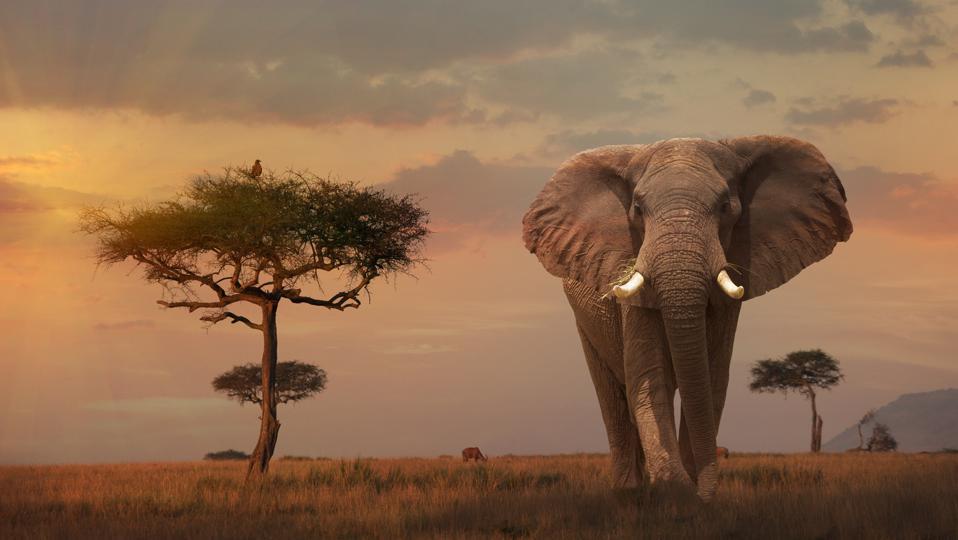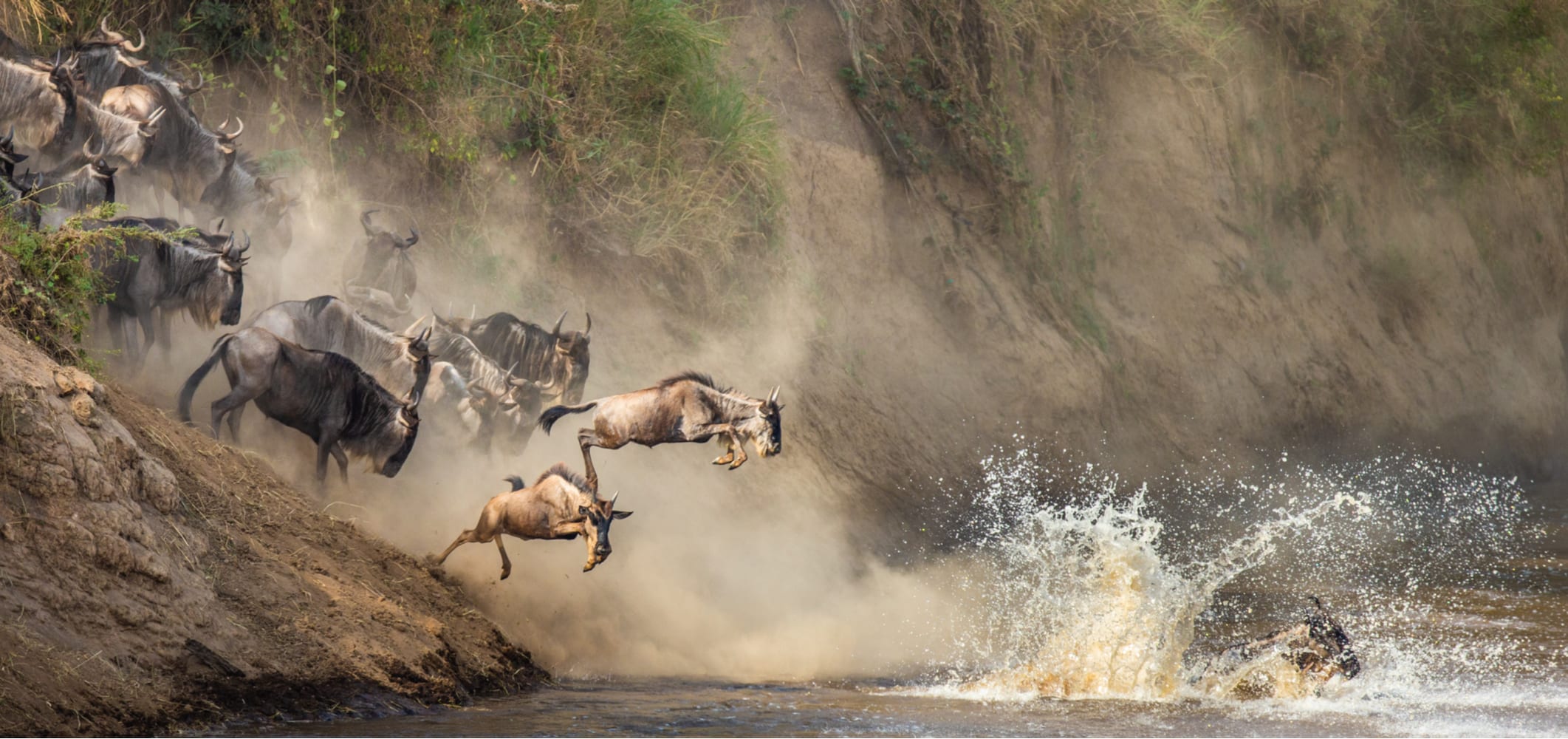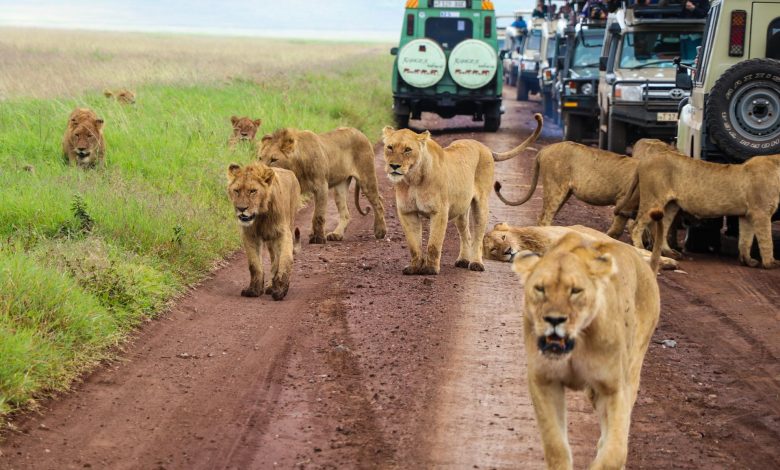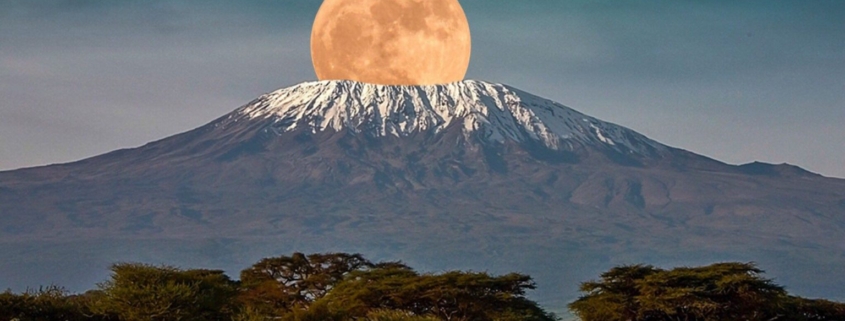Masai Mara or Serengeti
Masai Mara or Serengeti
Choosing between Masai Mara or Serengeti for your African safari ultimately depends on your personal preferences and priorities. Both of these world-famous safari destinations are part of the same cross-border ecosystem, sharing many similarities in landscapes and wildlife. However, there are some key differences to consider when choosing between Masai Mara or Serengeti, and your decision may also be influenced by the time of year you plan to visit. Here are some important points of comparison to help you determine which reserve suits you better between Masai Mara or Serengeti:
- Wildlife: Both the Serengeti and Masai Mara offer exceptional wildlife viewing, including the Big Five (lion, leopard, elephant, buffalo, and rhino). You’ll find a wide variety of animals in both parks, but the specific timing of the Great Migration can influence your choice. The Serengeti is renowned for its wildebeest migration, while the Masai Mara is where you’ll witness the dramatic river crossings.
- Landscapes: The landscapes of both parks are stunning, with vast savannahs and rolling plains. The Serengeti is known for its endless plains and kopjes (rocky outcrops), while the Masai Mara features picturesque acacia trees and the Mara River.
- Crowds: The Masai Mara tends to be more crowded, especially during the Great Migration season. The Serengeti offers a bit more space to spread out. If you prefer a quieter experience, the Serengeti might be a better choice.
- Accessibility: The Masai Mara is more accessible from Nairobi, Kenya, making it a popular choice for travelers coming from the Kenyan side. The Serengeti is typically accessed via Arusha, Tanzania. Your entry and exit points may influence your choice.
- Accommodation: Both reserves offer a range of accommodation options, from budget camps to luxury lodges. The variety of choices in the Masai Mara might be greater due to its popularity.
- Time of Year: If you specifically want to witness the Great Migration, your decision may depend on when you plan to visit. The wildebeest migration is an annual event, but its timing and location can vary.
In summary, there is no definitive “best” between the Masai Mara or Serengeti, as both have their unique qualities and offer incredible safari experiences. Your choice should be based on your interests, the specific experiences you’re seeking, and when you plan to visit. Consulting with a local safari expert can help you tailor your safari to meet your expectations.
Masai Mara or Serengeti 1: Habitat & Landscape
While the Masai Mara and Serengeti are integral parts of the greater Mara-Serengeti ecosystem, their landscapes do exhibit notable differences. The primary distinction lies in their respective sizes. The Serengeti, encompassing an expansive 14,760km² (5,700mi²), is vast, while the Masai Mara, with an area of 1,510km² (585mi²), is comparatively small.
The Serengeti is characterized by extensive open grasslands, but it also shelters a diverse array of other ecosystems, including rocky outcrops known as kopjes, evergreen riverine forests, and deciduous woodlands. As you journey from the southern region of the Serengeti towards the north, the landscape gradually transforms. The terrain becomes more hilly and wooded, ultimately leading to the Northern Serengeti and its extension into the Masai Mara. This shift in topography and vegetation can significantly influence the types of wildlife and experiences you encounter in each area.
Masai Mara or Serengeti 2: Wildlife
Both the Masai Mara and Serengeti offer exceptional wildlife viewing opportunities and are renowned for the annual wildebeest migration that traverses between Tanzania and Kenya. Beyond the migration, there is an abundance of resident wildlife in both parks. They are both Big Five destinations, providing reliable sightings of lion, leopard, buffalo, and elephant. You’ll also have the chance to spot cheetah, giraffe, and a wide array of other animals.
It’s important to note that rhinos are generally rare throughout the ecosystem, but the Masai Mara offers a higher likelihood of rhino sightings. In the western part of the Masai Mara, known as the Mara Triangle, you have an excellent chance of encountering these magnificent creatures.
The smaller size of the Masai Mara and its higher concentration of hotels and lodges can sometimes make it challenging to escape the crowds, particularly during peak tourist seasons. However, the greater number of vehicles on game drives in the Mara also results in more shared wildlife sightings, which can make wildlife viewing more accessible and rewarding.
In contrast, the Serengeti’s vast expanse provides more room to spread out, offering a bit more solitude and a sense of unspoiled wilderness. Ultimately, the choice between the Masai Mara and Serengeti may depend on your preference for crowd levels and the type of safari experience you seek.
Masai Mara or Serengeti 3: Best Time to Go
In general, the best time to visit either the Serengeti or the Masai Mara is during the dry months from approximately June to October. During this period, animals are drawn to available water sources, such as rivers and waterholes, which facilitates exceptional wildlife viewing. As the Dry season progresses, the vegetation begins to wither, making it easier to spot wildlife, particularly predators, which can be challenging to observe when the grass is tall and thick.
However, it’s important to note that the optimal time to witness the wildebeest migration varies between the Serengeti and the Masai Mara. The exact timing depends on rainfall patterns, but you stand a good chance of encountering the migration in the Serengeti from January to September. On the other hand, the prime time to witness the migration in the Masai Mara is from September to October. Planning your visit to align with these seasonal highlights can enhance your safari experience and provide an opportunity to witness one of nature’s most awe-inspiring events.
Masai Mara or Serengeti 4: the Great Migration
The circular annual migration of over 2 million grazers, primarily wildebeest but also zebras and gazelles, stands as one of Africa’s most awe-inspiring wildlife spectacles. It’s no wonder that many visitors plan their East Africa trips to witness this remarkable event. Given the larger expanse of the Serengeti, the great migration occurs in the Serengeti for a more extended period than in the Masai Mara.
January and February are particularly notable for a safari in the Southern Serengeti, as this is where the wildebeest temporarily interrupt their migration to give birth. During the peak of the calving season, thousands of calves are born each day, attracting a multitude of predators. As April draws to a close and the calves become strong enough to embark on their initial migration, the wildebeest and their accompanying wildlife begin their northward journey in long, boisterous columns.
Around June to July, they undertake the challenging crossing of the Grumeti River in the Serengeti’s Western Corridor, marking another remarkable migration highlight. The survivors continue their journey northward and typically reach the Mara River around August. This river crossing, considered one of the most thrilling moments of the great migration, can be observed from both the Serengeti and the Masai Mara sides of the ecosystem.
After all the wildebeest have successfully crossed, they spend approximately two months in the Mara before heading southward once more, returning to the Southern Serengeti. This remarkable cycle of the wildebeest’s migration offers a year-round spectacle, with each phase presenting unique and captivating wildlife encounters.
Masai Mara or Serengeti 5: Accommodation Options
Both the Serengeti and the Masai Mara offer a wide range of accommodation options to cater to the diverse preferences of visitors. These options encompass various styles, from tented camps (including both budget and exclusive high-end camps) to rustic boutique lodges and larger chain hotels and resorts. Tented camps, in particular, are quite popular in both parks. These camps can range from fully furnished units with canvas walls to more basic standing tents equipped with twin beds and minimal amenities.
Many of the top lodges in these parks aim to harmonize with the environment, adopting a down-to-earth approach. While they may not offer an abundance of modern conveniences, they prioritize eco-friendliness and strive to provide an exclusive experience characterized by excellent service, quality food, and expert guiding.
For those seeking a more basic yet highly exclusive experience, mobile camps are an option. These temporary camps follow the wildebeest migration without leaving any lasting environmental impact.
Although a broad spectrum of accommodation is available in both the Serengeti and the Masai Mara, the Serengeti boasts a substantial selection of small, upmarket lodgings. In contrast, the Masai Mara offers a few more mid-range options and a significant number of budget accommodations located just outside the reserve. When it comes to camping trips, safaris in the Serengeti often involve staying within the park, whereas budget camping trips to the Masai Mara typically take place outside the reserve. The variety of accommodations ensures that visitors can select options that align with their budget, preferences, and expectations while embarking on their safari adventures.
Masai Mara or Serengeti 6: Cost
In general, a safari in the Masai Mara tends to be more cost-effective than one in the Serengeti. Several factors contribute to this difference in pricing:
- Budget-Friendly Accommodation: The Masai Mara offers a greater number of budget-friendly accommodation options, including camps and lodges located outside the reserve. This variety allows travelers with tighter budgets to find suitable places to stay while still experiencing the safari.
- Location and Accessibility: The size of the Serengeti and its primary entry point through the Ngorongoro Conservation Area make staying outside the park and conducting day visits impractical. In contrast, the Masai Mara accommodates this option more readily, which can reduce costs for travelers who choose to stay outside the reserve.
- Accommodation Clustering: Well-priced accommodations inside the Masai Mara are often concentrated on the eastern side of the reserve, which can lead to crowding, particularly during peak tourist seasons. To escape the crowds, visitors might opt to stay on the quieter western side or the central plains of the Masai Mara, which may incur slightly higher costs.
- Private Conservancies: Staying in the private conservancies located to the north of the national reserve can provide a more secluded and intimate safari experience. These conservancies offer a wide range of accommodation options, and while they may be comparable in price to a Serengeti safari, they provide a more exclusive and tranquil atmosphere.
Ultimately, the Masai Mara offers greater flexibility in terms of budget accommodations and entry options, making it a more budget-friendly choice for many travelers. However, both the Masai Mara and the Serengeti offer diverse safari experiences, each with its unique attractions and charm. Travelers can select the option that aligns with their budget and preferences for their memorable East African safari adventure.
Masai Mara or Serengeti 7: Getting There
Reaching the Masai Mara and the Serengeti is generally straightforward, with well-established transportation options.
For the Masai Mara:
- Flights to Nairobi: Nairobi, as one of Africa’s major transport hubs, receives numerous flights from Europe and North America at competitive prices.
- Nairobi to Masai Mara: From Nairobi, travelers can catch a scheduled flight to the Masai Mara, which typically takes less than an hour. Several airlines operate daily flights to the various airstrips in the reserve.
- Flights from Other Kenyan Safari Destinations: There are also regular flights to the Masai Mara from other popular Kenyan safari destinations, such as Mombasa. These flights provide convenient access for tourists exploring multiple regions in Kenya.
- Road Travel: For those who prefer overland travel, the drive from Nairobi to the Masai Mara takes approximately five to six hours. The journey offers an opportunity to experience Kenya’s diverse landscapes.
For the Serengeti:
- Arusha, Tanzania: The primary gateway to the Serengeti is Arusha, a city in northern Tanzania. Most international travelers arrive in Tanzania via Kilimanjaro International Airport or Julius Nyerere International Airport in Dar es Salaam.
- Arusha to Serengeti: From Arusha, travelers can reach the Serengeti by taking a domestic flight. Several airlines operate scheduled flights to airstrips within the Serengeti, such as Seronera Airstrip.
- Road Travel: While the primary mode of accessing the Serengeti is by air, there are also overland options, but these are typically more time-consuming and require careful planning. The drive from Arusha to the Serengeti can take several hours, depending on the specific route taken.
Both the Masai Mara and the Serengeti offer accessible transportation options, allowing travelers to select the mode of travel that best suits their itineraries and preferences.
Serengeti gateway
The gateway to the Serengeti is Arusha, a city in northern Tanzania. Arusha is well-serviced by two airports:
- Kilimanjaro International Airport: This airport accommodates both international and some domestic flights, making it a key entry point for international travelers to reach Arusha.
- Arusha Airport: Arusha Airport primarily handles domestic flights. It serves as a convenient departure point for travelers on domestic flights, connecting them to various destinations within Tanzania.
Travelers visiting the Serengeti have several options for accessing the park:
- Flights to Serengeti: It is possible to fly in and out of the Serengeti from Arusha, with several airstrips within the Serengeti providing access to different areas of the park. These flights offer a quick and efficient way to reach the Serengeti.
- Road Safaris: Many travelers opt for road safaris that cover the Northern safari circuit. The journey from Arusha to the Serengeti by road takes you through the Ngorongoro Conservation Area, providing the option to visit the renowned Ngorongoro Crater.
- Visit Other Parks: Travelers on this route can explore other national parks in Tanzania, such as Lake Manyara and Tarangire National Parks. This comprehensive circuit allows for a diverse safari experience, incorporating a range of landscapes and wildlife encounters.
Arusha, with its proximity to Kilimanjaro International Airport and Arusha Airport, is a strategic base for travelers embarking on safaris to the Serengeti and other northern Tanzanian wildlife destinations. The variety of transportation options ensures that visitors can choose the most suitable means of reaching the Serengeti to start their safari adventures.



